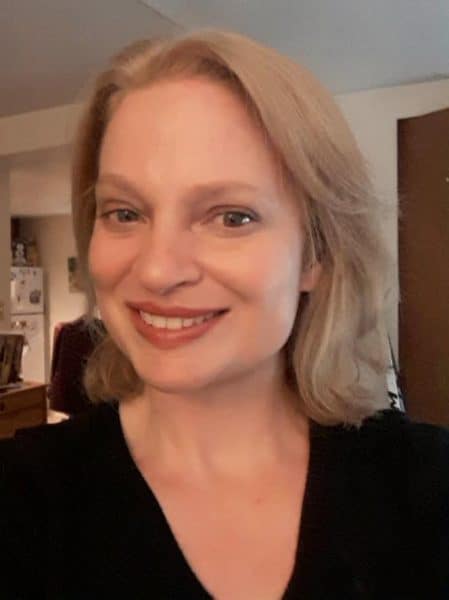Heather M. realized she had hearing loss when she was 15, and for more than half her life, she struggled and watched her grandmother struggle with hearing loss too. Now in her 40s, Heather learned that hearing loss didn’t have to be a lifetime battle like it was for her beloved grandmother. Read Heather’s journey to her cochlear implant and the Kanso® Sound Processor:
 “I’ve been hard of hearing since my late teens…and maybe even earlier.
“I’ve been hard of hearing since my late teens…and maybe even earlier.
Looking back, I can see that I wasn’t hearing the way that other people did, even when I was only 15 years of age. However, while I was a teen, I’d been too young to understand that I had a problem.
I guess I thought that my hearing was the same as everyone else’s. Maybe I assumed that I missed things during classes sometimes because I wasn’t as bright as my peers.
My grandmother had also lost her hearing around the same age. Her hearing deteriorated over the years, just as mine was fated to do. So I had some experience with hearing loss before it really happened to me.
My grandmother showed me that people with hearing loss were intelligent, courageous and fun-loving people. They just have trouble hearing.
I’m grateful that I had this role model, although I didn’t realize that I was destined to go through the same thing.
 My grandmother baked the best bread in the world, and she beat us all at Trivial Pursuit and Scrabble because she was just so smart. She loved the Toronto Blue Jays and raised four beautiful children with her husband, who was a World War II veteran. My grandmother was a very strong woman.
My grandmother baked the best bread in the world, and she beat us all at Trivial Pursuit and Scrabble because she was just so smart. She loved the Toronto Blue Jays and raised four beautiful children with her husband, who was a World War II veteran. My grandmother was a very strong woman.
She grew up in the time before political correctness. Being hard of hearing wasn’t so easy back then. There was more stigma. Things must have been very hard for her, but she persevered.
When I think what a cochlear implant would have done for her, I feel so sad because I wish that she could have had one. However, she got a lot from life, even though her hearing loss was surely a burden.
Hearing loss doesn’t have to last a lifetime
Now, I’m in my late 40s. Until I had a cochlear implant (which I received in June of this year), I thought that my hearing loss, that had started out moderate and plummeted to near profound, was something that I would have to live with forever.
That’s the way it had been for my grandmother. It would be the same for me. Wouldn’t it?
I’ve touched on the downside of hearing loss. Is there an upside? Perhaps…
Hearing loss gives a person a great deal of perseverance and that’s probably the blessing in hearing loss. Living with it day and night for decades really tests a person.
I know that the perseverance I’ve developed due to living with this type of invisible disability has allowed me to handle other problems in my life head-on. I’m not unbreakable, but I’m not weak, either. Hearing loss is a character-builder.
However, life is about more than having strength of character. Life is supposed to be fun…a grand adventure filled with love, laughter and new experiences. While I had plenty of good times before I signed on for a cochlear implant, I knew that getting the implant would allow me to get more from my own life. It would give me more personal freedom.
While I had fears (What if my cochlear implant doesn’t work? How hard will it be to recover from the surgery?), I also knew instinctively that it was time. I probably should have gotten the cochlear implant long before I did.
Why the Kanso was right for me
The next step was deciding which sound processor was right for my needs. I was looking at Cochlear’s Nucleus® 6 Sound Processor and their Kanso Sound Processor and eventually decided on the Kanso because it’s worn off the ear, it’s small enough to conceal beneath my hair and I only press one button to turn it on and off.
It’s small, it’s simple, it’s compatible with Cochlear’s True Wireless™ accessories and other Bluetooth®-connected assistive technologies.
I wanted the design that granted me the most freedom, and I love my little processor!
My hearing in my implanted ear is now triple what it used to be with a hearing aid. My Kanso Sound Processor makes going to restaurants (where there is plenty of noise coming from all directions) pleasurable again, rather than stressful. It has made everything more fun. It suits my needs and my wants.
The Kanso Sound Processor stays in place unless I knock it off through some clumsiness of my own. Even then, it’s securely tethered underneath my hair with the hair clip.
My Kanso is the personal possession that I treasure most. I applaud Cochlear for providing people like me, who want discretion and simplicity, with access to the Kanso Sound Processor. It’s really an elegant solution to the problem of hearing loss.
While I don’t have perfect hearing now, I’ve moved forward leaps and bounds. Things are so much easier than they used to be.
I was sick of dealing with my hearing loss, and it was a burden I was thrilled to shrug off. I’m glad to find a better way of hearing with my cochlear implant and my Kanso Sound Processor.”
If you’re struggling with hearing loss and hearing aids are not working for you, click here to find out if a cochlear implant could benefit you.